Man, I’ve got a great lick for you
this month.
How can I motivate you to learn these five notes? I’ll try a Pee Wee Herman reference.
Do you remember the scene in Pee Wee’s Big Adventure where Pee Wee starts showing off by doing athletic stunts on his bicycle, then loses control, and crashes in front of a bunch of neighborhood kids? He gets up and says, “I meant to do that.”
I wouldn’t be surprised if a significant percentage of ’80s shred guitar solos were created in a similar spirit. Imagine the scene: The spandex-wearing, big-haired dude with a whammy bar doesn’t really know what he’s doing. The engineer hits the record button on the big 2" tape machine and the song starts to play. The guitarist moves his fingers as fast as he can and takes some wild guesses about where to bend and where to end. After 10 takes of near gibberish, he gets lucky and plays something that locks into the key and the groove. He turns to the producer and says, “I meant to do that.”
Now, I must go on record by saying that I fully support the “happy accident.” This is rock ’n’ roll, not Mozart. At the same time, the world could use a bit less gibberish and a higher percentage of ... melodic intention.
What do I mean by this? I mean playing well-selected notes on purpose because you like the way they sound, not just because they happen to fall in a convenient spot where your fingers were going anyway.
How does one do this? Let’s start with some good notes. And that requires a tiny amount of music theory.
I present you with: THE SINGLE MOST IMPORTANT THING A ROCK GUITAR PLAYER SHOULD KNOW FROM THE IMPOSING ENCYCLOPEDIA OF MUSIC THEORY.
I think that we all have varying degrees of tolerance for “book learning.” I will assume that you, the reader, have a low tolerance. So my job is to quickly and painlessly present you with an extremely useful idea, and then get back to playing the music before your eyes blur with boredom.
So here it is: Which 6th should you use?
That’s it. Now, since you’re a rock guitar player, I’ll assume you are playing in minor most of the time. But which minor? Natural minor (aka Aeolian) or Dorian? The 6th degree is the note that tells you.
Let me list some tunes you might know, according to their 6th.
Minor scale containing the minor 6th (b6). This is natural minor:
“Crazy Train” (intro and solo)
“Stairway to Heaven” (end solo)
“All Along the Watchtower” (rhythm part)
“Suffragette City” (rhythm part)
Minor scale containing the major 6th (6). This is Dorian:
“Satisfaction” (intro)
“Highway to Hell”
“Born to Be Wild”
“Cold Gin” (intro)
The important idea is to know which 6th is in the chord progression, so you can use the same one in your solo. Being a “heavy metal guy” in my teenage years, I heavily favored the minor 6th for years. Later, when I tried soloing over rock tunes with a blues influence, my habitual minor 6th sounded horrible over bluesier tunes. It’s something that’s pretty obvious by ear, but good to be aware of before blasting into a solo.
Now this is all very general. Let’s get into my specific solution for the 6th problem, which is: Don’t play it at all!
And while we’re at it, let’s leave out the 4th too. Why? Because it’s not a chord tone and when I leave it out, the key becomes more focused, and I just like the sound better. That’s why.
So we are left with the root, minor 3rd (b3), fifth, minor 7th (b7), and the 9th—all good notes. These are all strong chord tones (1–b3–5–b7) plus one well-chosen extension (9). By the way, the 9th is the “Sade” note. Listen to her vocal melodies in “Smooth Operator” and “The Sweetest Taboo”—the 9th is everywhere!
Let’s give these good notes a name. Let’s call it a minor 9th arpeggio.
We are now full of melodic intention. We mean to play these notes. And we also mean not to play some other ones. Now all we need is a good fingering. I’ve taken the trouble to work one out for you. Check out Fig. 1. The red notes indicate where the root lives. In this case, we are in the key of E minor.
Download Example Audio...

There they are, five good notes—Em9. And the good news is, they fit on two strings. This is wonderful because you can use the same shape and fingering on the next two strings, and then again on the last two strings. Yes, you do have to quickly shift your left hand position, but that is a small inconvenience in exchange for easy visualization. In other words, this lick is super-easy for your eyes and brain. And your fingers will follow.
One important technical note: I recommend not picking everything. Fig. 2 is an example of how to combine some picking with hammer-ons and pull-offs to make the lick easier to play and sound smoother.
Download Example Audio...

I’ve found that these shapes are very useful for fast sixteenth-note improvising. If you compare the sound of these shapes to more typical scales (natural minor or Dorian), you’ll hear a real difference in how the Em9 arpeggio does a much better job in focusing your ear on the key and just sounds more “intentional.” You meant to play that.
Au revoir, Pee Wee!
Check out Seven Solos that Melted Paul Gilbert's Face on Page 2...
 Paul Gilbert purposefully began playing guitar
at age 9, formed the guitar-driven bands
Racer X and Mr. Big, and then accidentally
had a No. 1 hit with an acoustic song called
“To Be with You.” Paul began teaching at
GIT at the age of 18, has released countless
albums and guitar instructional DVDs, and
will remembered as “the guy who got the drill
stuck in his hair.” For more information, visit
paulgilbert.com
Paul Gilbert purposefully began playing guitar
at age 9, formed the guitar-driven bands
Racer X and Mr. Big, and then accidentally
had a No. 1 hit with an acoustic song called
“To Be with You.” Paul began teaching at
GIT at the age of 18, has released countless
albums and guitar instructional DVDs, and
will remembered as “the guy who got the drill
stuck in his hair.” For more information, visit
paulgilbert.com
Seven Solos that Melted My Face
I have to start by saying Eddie Van Halen, Yngwie Malmsteen, and Jimmy Page have been so well covered that I’m going to give them a quick, respectful “I’m not worthy” bow, and move on to some lesser-known, but still thoroughly face-melting guitarists. I chose these songs with one specific requirement in mind: These are solos I actually sat down and learned. I tried hard to play specific parts of them, and although I couldn’t always play them perfectly or completely, I definitely came away with some great phrases and inspiration. Please seek these out and give them a listen.
 1. Song: “In the World of Giants”
1. Song: “In the World of Giants”
Guitarist: Kim Mitchell
Max Webster, like Jethro Tull and Lynyrd Skynyrd before him, is not actually a member of the band. Kim Mitchell is the guitarist, singer, and creative force behind this Canadian rock-prog-fusion-pop band. Kim blasts out an amazing intro of picked 16th-note triplets in this song. Not only is he fast, but his tone is flawless, and he’s so locked into the groove that you can stomp your foot to it. The song itself is a great rocking shuffle, and his guitar solo in the middle was one of my first exposures to playing “outside.” Plus, Kim is wearing some kind of bright yellow satin jumpsuit while flying through the air on the album cover.
 2. Song: “Mother Mary”
2. Song: “Mother Mary”
Guitarist: Michael Schenker
Check out the live version and listen to Michael Schenker rip through some descending fours with power and ease. It took me a long time to figure out that these are played on a single string. Yngwie made a franchise out of this lick, but Schenker played it first.
 3. Song: “Harpsichord Concerto in A Major”
3. Song: “Harpsichord Concerto in A Major”
Composer: Johann Christian Bach
How many hundreds of years ago was this written? I’m not sure. But it was long ago when TV, video games, email, and Facebook didn’t distract musicians. In other words, there wasn’t much to do except practice. And it shows in classical pieces like this one. Okay, it’s not guitar, but I still tried to learn the beautiful and simultaneously face-melting harpsichord solos in this piece. If you want to hear my guitar version of it, listen to “Gilberto Concerto” on my Flying Dog record. I also used a chunk of it in “Scarified” by Racer X.
 4. Song: “End of the World”
4. Song: “End of the World”
Guitarist: Gary Moore
Gary Moore gained fame as a blues guitar player, but in the ’80s he was metal, metal, metal. Have you heard his Corridors of Power record? No? Well then, put down this magazine and go get that thing. The whole record is great, but Gary’s solo in “End of the World” is the definition of “face melting.” Seriously, you’re not going to believe it. Go get that record!
 5. Song: “Exploder”
5. Song: “Exploder”
Guitarist: Akira Takasaki
Akira Takasaki is the Japanese Gary Moore, Van Halen, Alex Lifeson, and Richie Blackmore all rolled into one. You can hear his influences, but they are excellent influences, and he mixes them into his own incredible style. This is from an album called Disillusion. The whole album was a huge influence on my early Racer X playing and writing.
 6. Song: “Answer to the Master”
6. Song: “Answer to the Master”
Guitarists: Pete Willis and Steve Clark
This song is from the very first Def Leppard album when Pete Willis and Steve Clark both played lead guitar in the band. I don’t know which one of them played the solos in this song, but the result is one of the most glorious air-guitar moments I can think of. The main riff is creative and rocking at the same time. Yes, 1980 was a great year to be a metal fan.
 7. Song: “Boom Boom (Out Go the Lights)”
7. Song: “Boom Boom (Out Go the Lights)”
Guitarists: Pat Travers and Pat Thrall
And 1979 wasn’t bad either. Pat Travers and Pat Thrall remain my favorite dual-guitar team of all time. On this live recording, their guitars are panned hard to the left and right channels, so you can easily hear what each Pat is playing. Both their rhythm parts and lead parts made a huge mark on my style. In the mid ’80s, when I found myself getting too deep into harmonic minor Bach-rock, I brought myself back to this song, learned the solos as best I could, and my rock-blues soul was literally saved! But with face-melting phrases still at full force! The rest of the album is great too. And you can hear where I got the idea for getting crazy sounds out of an old A/DA Flanger or my new Airplane Flanger.
 Paul Gilbert purposefully began playing guitar
at age 9, formed the guitar-driven bands
Racer X and Mr. Big, and then accidentally
had a No. 1 hit with an acoustic song called
“To Be with You.” Paul began teaching at
GIT at the age of 18, has released countless
albums and guitar instructional DVDs, and
will remembered as “the guy who got the drill
stuck in his hair.” For more information, visit
paulgilbert.com
Paul Gilbert purposefully began playing guitar
at age 9, formed the guitar-driven bands
Racer X and Mr. Big, and then accidentally
had a No. 1 hit with an acoustic song called
“To Be with You.” Paul began teaching at
GIT at the age of 18, has released countless
albums and guitar instructional DVDs, and
will remembered as “the guy who got the drill
stuck in his hair.” For more information, visit
paulgilbert.com
How can I motivate you to learn these five notes? I’ll try a Pee Wee Herman reference.
Do you remember the scene in Pee Wee’s Big Adventure where Pee Wee starts showing off by doing athletic stunts on his bicycle, then loses control, and crashes in front of a bunch of neighborhood kids? He gets up and says, “I meant to do that.”
I wouldn’t be surprised if a significant percentage of ’80s shred guitar solos were created in a similar spirit. Imagine the scene: The spandex-wearing, big-haired dude with a whammy bar doesn’t really know what he’s doing. The engineer hits the record button on the big 2" tape machine and the song starts to play. The guitarist moves his fingers as fast as he can and takes some wild guesses about where to bend and where to end. After 10 takes of near gibberish, he gets lucky and plays something that locks into the key and the groove. He turns to the producer and says, “I meant to do that.”
Now, I must go on record by saying that I fully support the “happy accident.” This is rock ’n’ roll, not Mozart. At the same time, the world could use a bit less gibberish and a higher percentage of ... melodic intention.
What do I mean by this? I mean playing well-selected notes on purpose because you like the way they sound, not just because they happen to fall in a convenient spot where your fingers were going anyway.
How does one do this? Let’s start with some good notes. And that requires a tiny amount of music theory.
I present you with: THE SINGLE MOST IMPORTANT THING A ROCK GUITAR PLAYER SHOULD KNOW FROM THE IMPOSING ENCYCLOPEDIA OF MUSIC THEORY.
I think that we all have varying degrees of tolerance for “book learning.” I will assume that you, the reader, have a low tolerance. So my job is to quickly and painlessly present you with an extremely useful idea, and then get back to playing the music before your eyes blur with boredom.
So here it is: Which 6th should you use?
That’s it. Now, since you’re a rock guitar player, I’ll assume you are playing in minor most of the time. But which minor? Natural minor (aka Aeolian) or Dorian? The 6th degree is the note that tells you.
Let me list some tunes you might know, according to their 6th.
Minor scale containing the minor 6th (b6). This is natural minor:
“Crazy Train” (intro and solo)
“Stairway to Heaven” (end solo)
“All Along the Watchtower” (rhythm part)
“Suffragette City” (rhythm part)
Minor scale containing the major 6th (6). This is Dorian:
“Satisfaction” (intro)
“Highway to Hell”
“Born to Be Wild”
“Cold Gin” (intro)
The important idea is to know which 6th is in the chord progression, so you can use the same one in your solo. Being a “heavy metal guy” in my teenage years, I heavily favored the minor 6th for years. Later, when I tried soloing over rock tunes with a blues influence, my habitual minor 6th sounded horrible over bluesier tunes. It’s something that’s pretty obvious by ear, but good to be aware of before blasting into a solo.
Now this is all very general. Let’s get into my specific solution for the 6th problem, which is: Don’t play it at all!
And while we’re at it, let’s leave out the 4th too. Why? Because it’s not a chord tone and when I leave it out, the key becomes more focused, and I just like the sound better. That’s why.
So we are left with the root, minor 3rd (b3), fifth, minor 7th (b7), and the 9th—all good notes. These are all strong chord tones (1–b3–5–b7) plus one well-chosen extension (9). By the way, the 9th is the “Sade” note. Listen to her vocal melodies in “Smooth Operator” and “The Sweetest Taboo”—the 9th is everywhere!
Let’s give these good notes a name. Let’s call it a minor 9th arpeggio.
We are now full of melodic intention. We mean to play these notes. And we also mean not to play some other ones. Now all we need is a good fingering. I’ve taken the trouble to work one out for you. Check out Fig. 1. The red notes indicate where the root lives. In this case, we are in the key of E minor.
Download Example Audio...
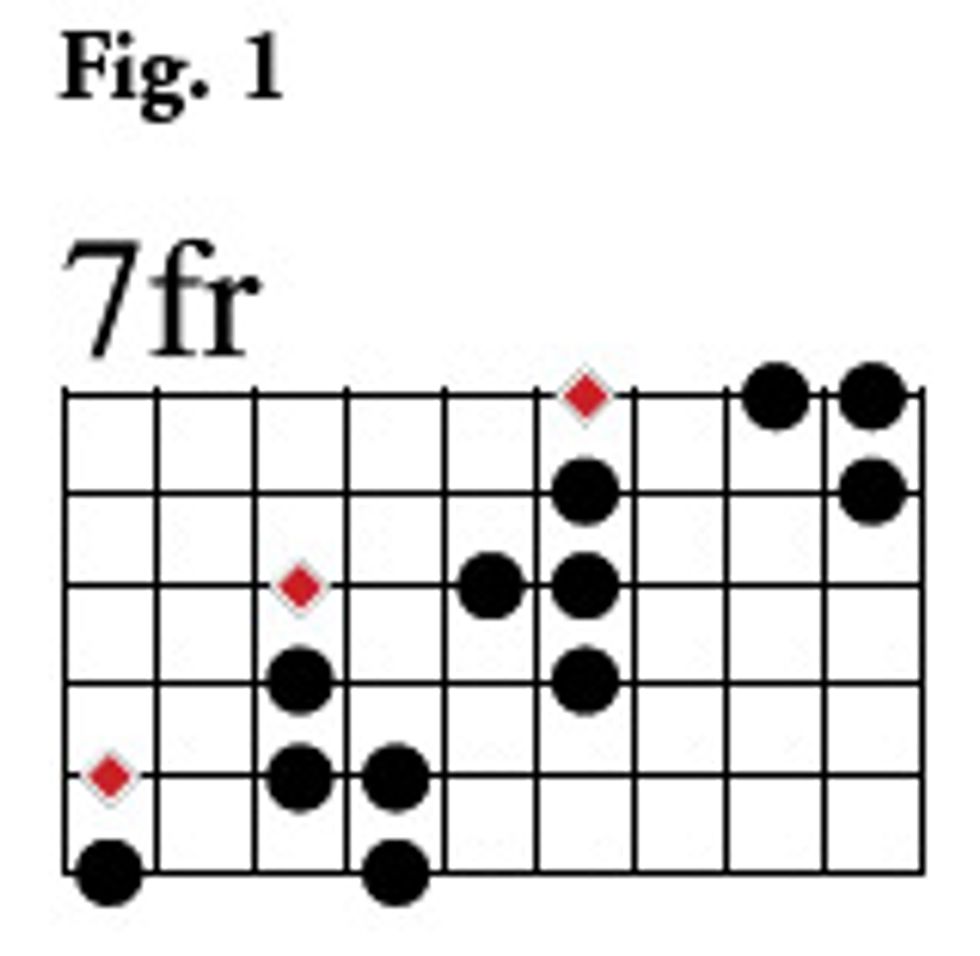
There they are, five good notes—Em9. And the good news is, they fit on two strings. This is wonderful because you can use the same shape and fingering on the next two strings, and then again on the last two strings. Yes, you do have to quickly shift your left hand position, but that is a small inconvenience in exchange for easy visualization. In other words, this lick is super-easy for your eyes and brain. And your fingers will follow.
One important technical note: I recommend not picking everything. Fig. 2 is an example of how to combine some picking with hammer-ons and pull-offs to make the lick easier to play and sound smoother.
Download Example Audio...
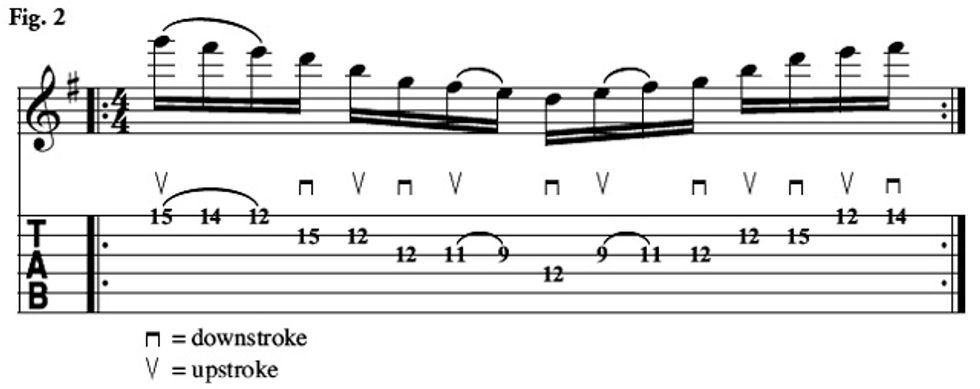
I’ve found that these shapes are very useful for fast sixteenth-note improvising. If you compare the sound of these shapes to more typical scales (natural minor or Dorian), you’ll hear a real difference in how the Em9 arpeggio does a much better job in focusing your ear on the key and just sounds more “intentional.” You meant to play that.
Au revoir, Pee Wee!
Check out Seven Solos that Melted Paul Gilbert's Face on Page 2...
 Paul Gilbert purposefully began playing guitar
at age 9, formed the guitar-driven bands
Racer X and Mr. Big, and then accidentally
had a No. 1 hit with an acoustic song called
“To Be with You.” Paul began teaching at
GIT at the age of 18, has released countless
albums and guitar instructional DVDs, and
will remembered as “the guy who got the drill
stuck in his hair.” For more information, visit
paulgilbert.com
Paul Gilbert purposefully began playing guitar
at age 9, formed the guitar-driven bands
Racer X and Mr. Big, and then accidentally
had a No. 1 hit with an acoustic song called
“To Be with You.” Paul began teaching at
GIT at the age of 18, has released countless
albums and guitar instructional DVDs, and
will remembered as “the guy who got the drill
stuck in his hair.” For more information, visit
paulgilbert.comSeven Solos that Melted My Face
I have to start by saying Eddie Van Halen, Yngwie Malmsteen, and Jimmy Page have been so well covered that I’m going to give them a quick, respectful “I’m not worthy” bow, and move on to some lesser-known, but still thoroughly face-melting guitarists. I chose these songs with one specific requirement in mind: These are solos I actually sat down and learned. I tried hard to play specific parts of them, and although I couldn’t always play them perfectly or completely, I definitely came away with some great phrases and inspiration. Please seek these out and give them a listen.
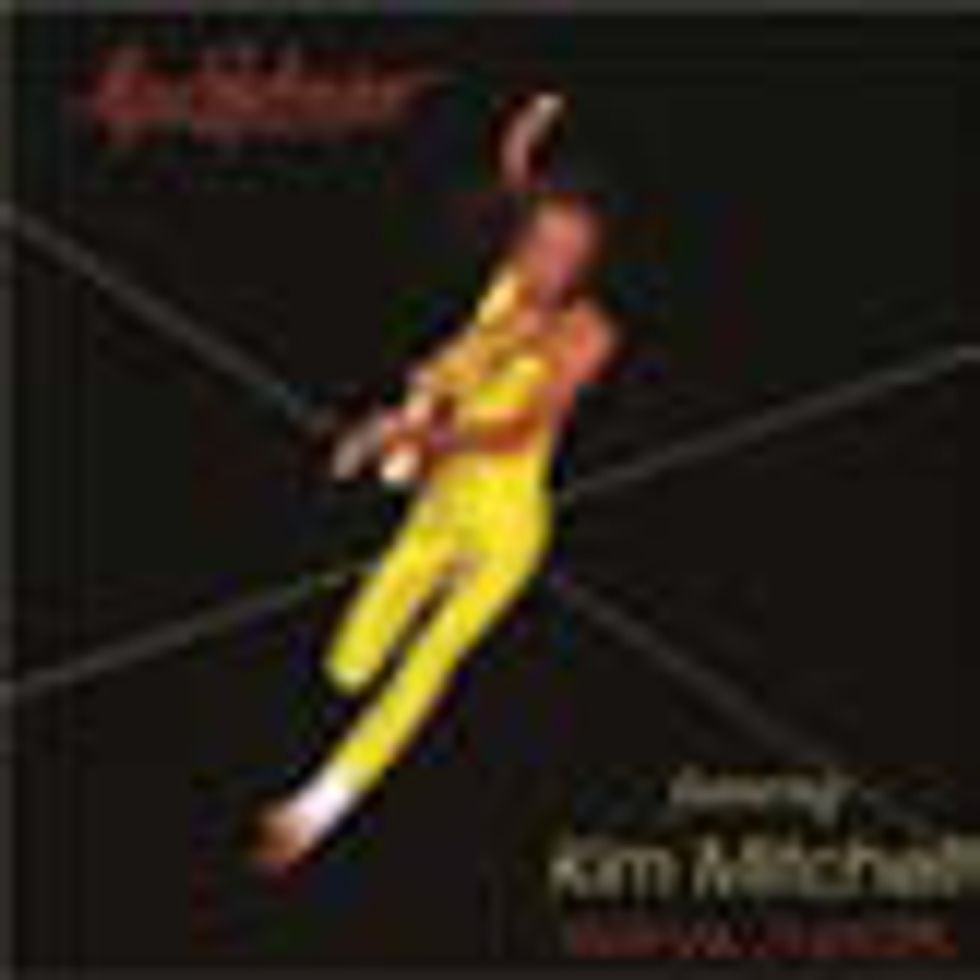 1. Song: “In the World of Giants”
1. Song: “In the World of Giants”Guitarist: Kim Mitchell
Max Webster, like Jethro Tull and Lynyrd Skynyrd before him, is not actually a member of the band. Kim Mitchell is the guitarist, singer, and creative force behind this Canadian rock-prog-fusion-pop band. Kim blasts out an amazing intro of picked 16th-note triplets in this song. Not only is he fast, but his tone is flawless, and he’s so locked into the groove that you can stomp your foot to it. The song itself is a great rocking shuffle, and his guitar solo in the middle was one of my first exposures to playing “outside.” Plus, Kim is wearing some kind of bright yellow satin jumpsuit while flying through the air on the album cover.
 2. Song: “Mother Mary”
2. Song: “Mother Mary”Guitarist: Michael Schenker
Check out the live version and listen to Michael Schenker rip through some descending fours with power and ease. It took me a long time to figure out that these are played on a single string. Yngwie made a franchise out of this lick, but Schenker played it first.
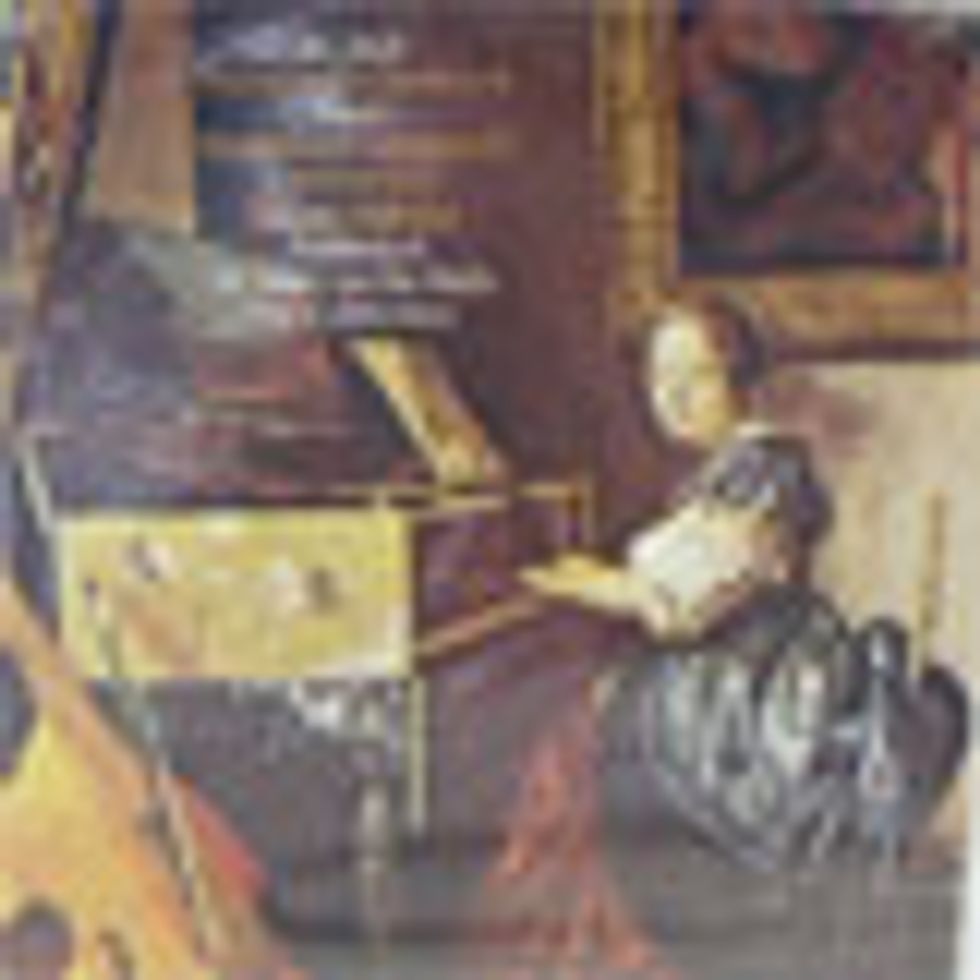 3. Song: “Harpsichord Concerto in A Major”
3. Song: “Harpsichord Concerto in A Major”Composer: Johann Christian Bach
How many hundreds of years ago was this written? I’m not sure. But it was long ago when TV, video games, email, and Facebook didn’t distract musicians. In other words, there wasn’t much to do except practice. And it shows in classical pieces like this one. Okay, it’s not guitar, but I still tried to learn the beautiful and simultaneously face-melting harpsichord solos in this piece. If you want to hear my guitar version of it, listen to “Gilberto Concerto” on my Flying Dog record. I also used a chunk of it in “Scarified” by Racer X.
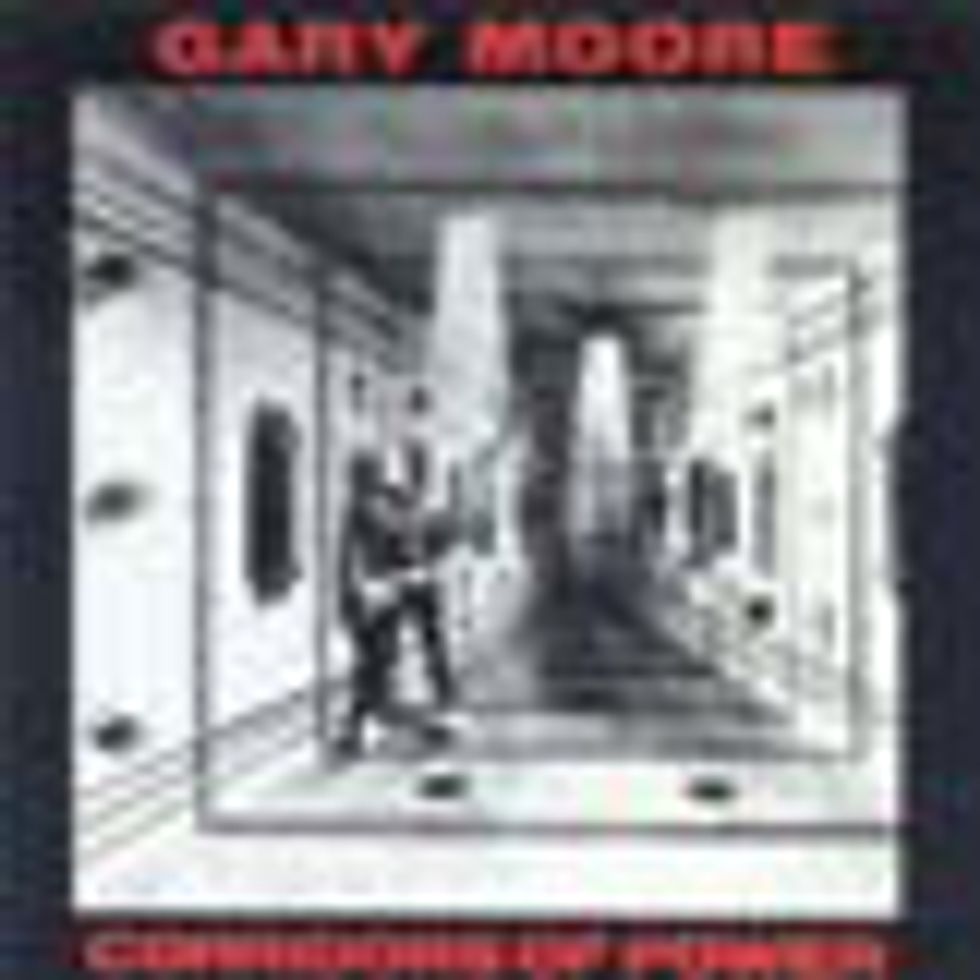 4. Song: “End of the World”
4. Song: “End of the World”Guitarist: Gary Moore
Gary Moore gained fame as a blues guitar player, but in the ’80s he was metal, metal, metal. Have you heard his Corridors of Power record? No? Well then, put down this magazine and go get that thing. The whole record is great, but Gary’s solo in “End of the World” is the definition of “face melting.” Seriously, you’re not going to believe it. Go get that record!
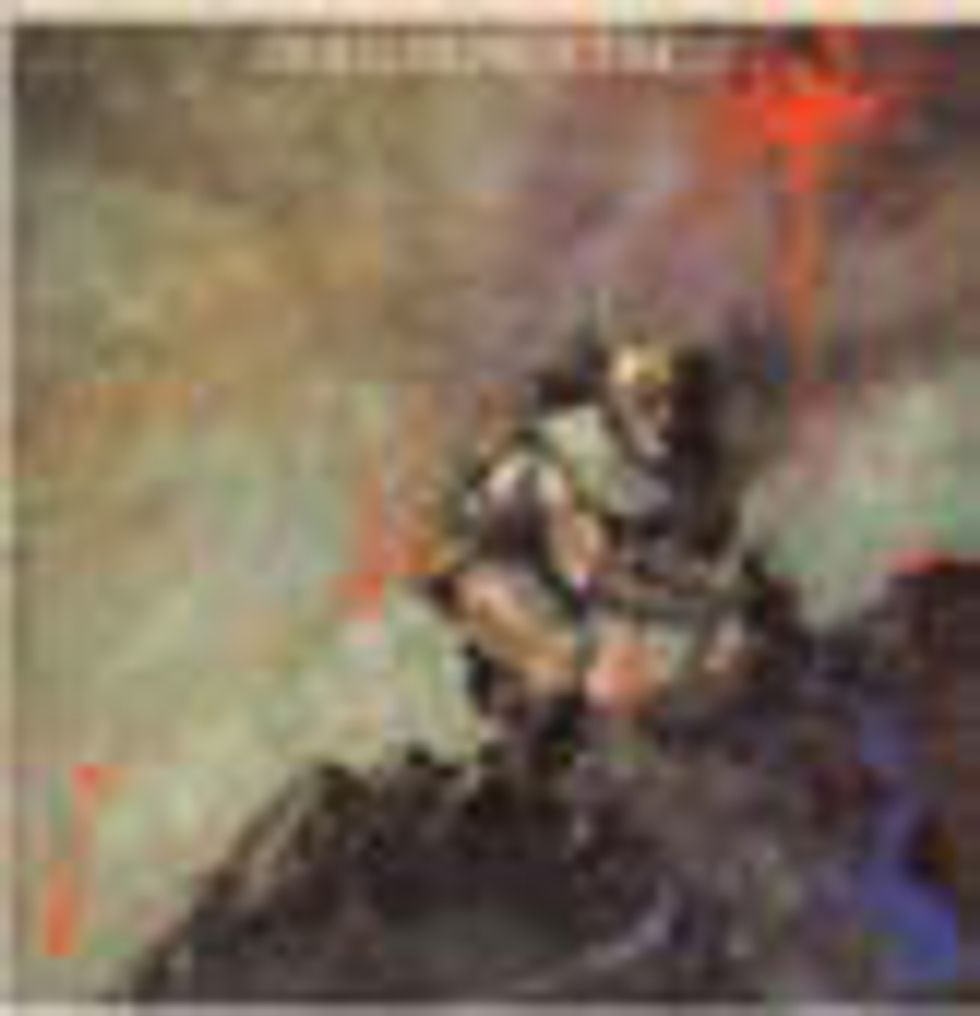 5. Song: “Exploder”
5. Song: “Exploder”Guitarist: Akira Takasaki
Akira Takasaki is the Japanese Gary Moore, Van Halen, Alex Lifeson, and Richie Blackmore all rolled into one. You can hear his influences, but they are excellent influences, and he mixes them into his own incredible style. This is from an album called Disillusion. The whole album was a huge influence on my early Racer X playing and writing.
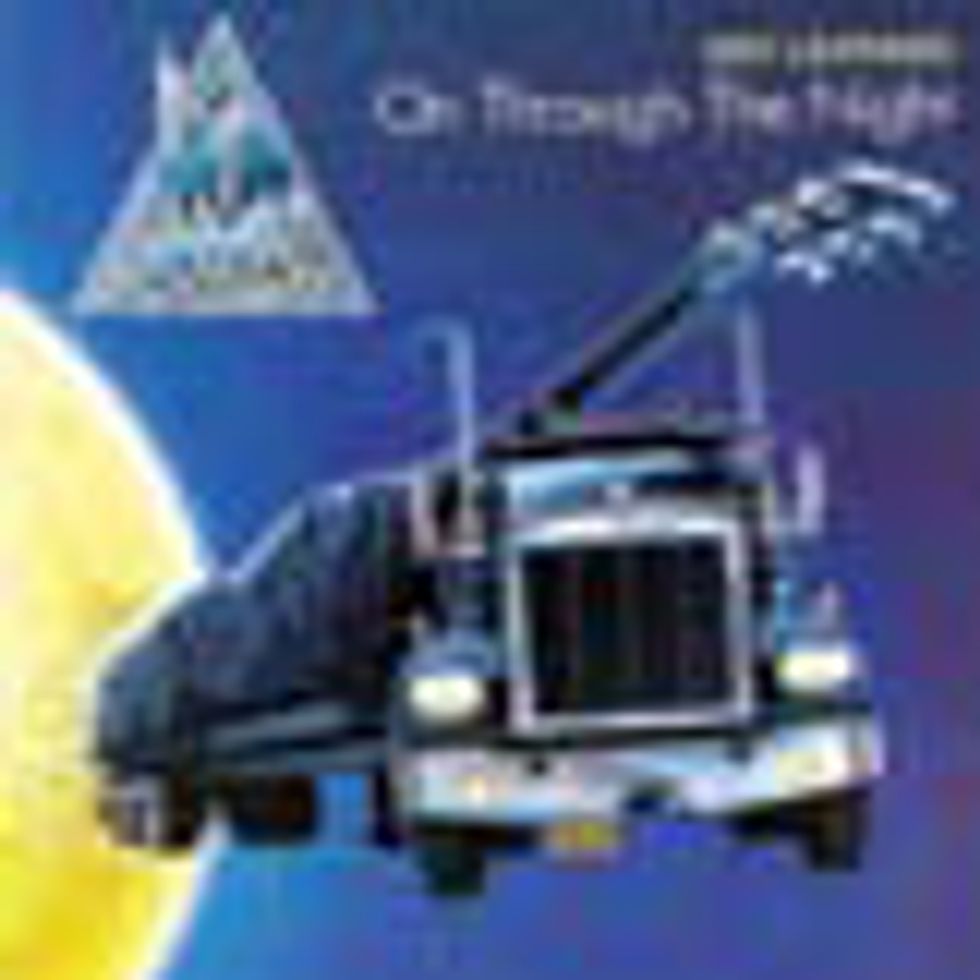 6. Song: “Answer to the Master”
6. Song: “Answer to the Master”Guitarists: Pete Willis and Steve Clark
This song is from the very first Def Leppard album when Pete Willis and Steve Clark both played lead guitar in the band. I don’t know which one of them played the solos in this song, but the result is one of the most glorious air-guitar moments I can think of. The main riff is creative and rocking at the same time. Yes, 1980 was a great year to be a metal fan.
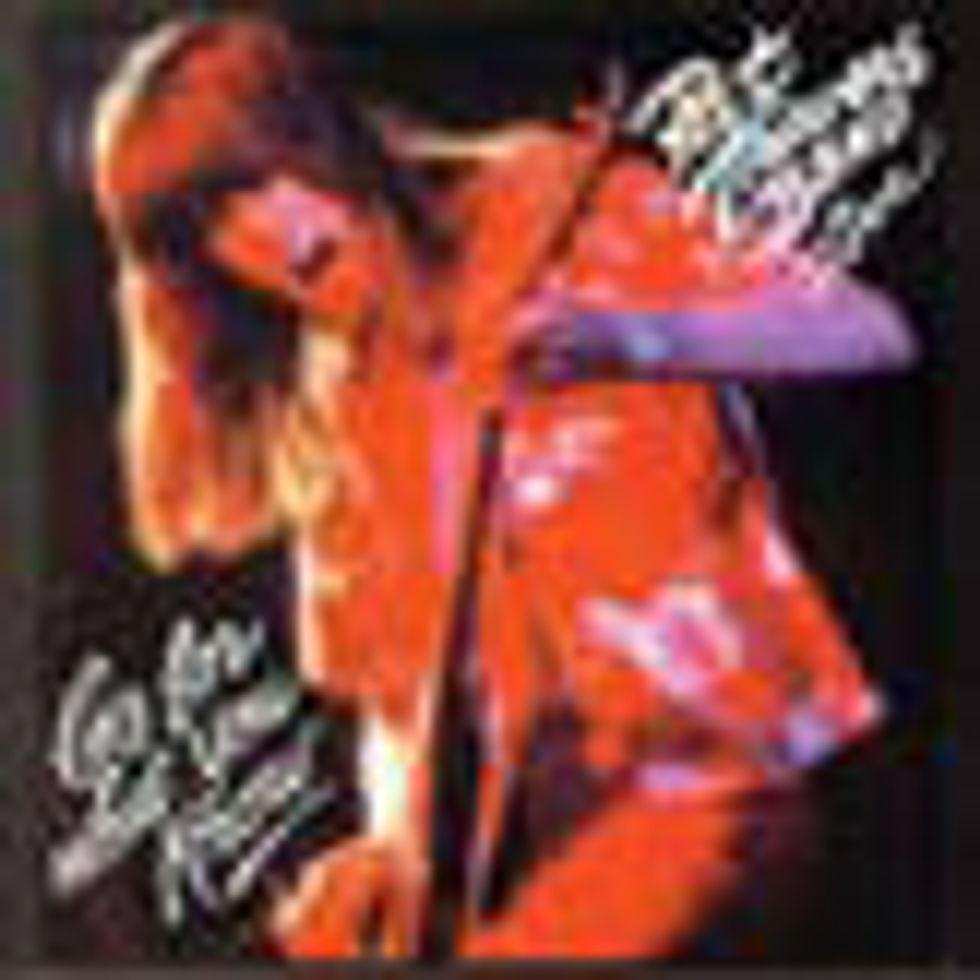 7. Song: “Boom Boom (Out Go the Lights)”
7. Song: “Boom Boom (Out Go the Lights)”Guitarists: Pat Travers and Pat Thrall
And 1979 wasn’t bad either. Pat Travers and Pat Thrall remain my favorite dual-guitar team of all time. On this live recording, their guitars are panned hard to the left and right channels, so you can easily hear what each Pat is playing. Both their rhythm parts and lead parts made a huge mark on my style. In the mid ’80s, when I found myself getting too deep into harmonic minor Bach-rock, I brought myself back to this song, learned the solos as best I could, and my rock-blues soul was literally saved! But with face-melting phrases still at full force! The rest of the album is great too. And you can hear where I got the idea for getting crazy sounds out of an old A/DA Flanger or my new Airplane Flanger.
 Paul Gilbert purposefully began playing guitar
at age 9, formed the guitar-driven bands
Racer X and Mr. Big, and then accidentally
had a No. 1 hit with an acoustic song called
“To Be with You.” Paul began teaching at
GIT at the age of 18, has released countless
albums and guitar instructional DVDs, and
will remembered as “the guy who got the drill
stuck in his hair.” For more information, visit
paulgilbert.com
Paul Gilbert purposefully began playing guitar
at age 9, formed the guitar-driven bands
Racer X and Mr. Big, and then accidentally
had a No. 1 hit with an acoustic song called
“To Be with You.” Paul began teaching at
GIT at the age of 18, has released countless
albums and guitar instructional DVDs, and
will remembered as “the guy who got the drill
stuck in his hair.” For more information, visit
paulgilbert.com

















